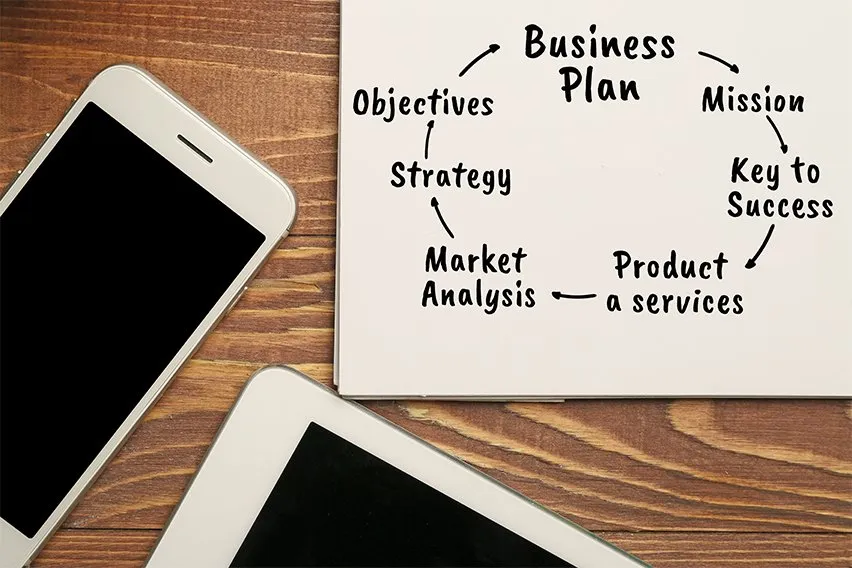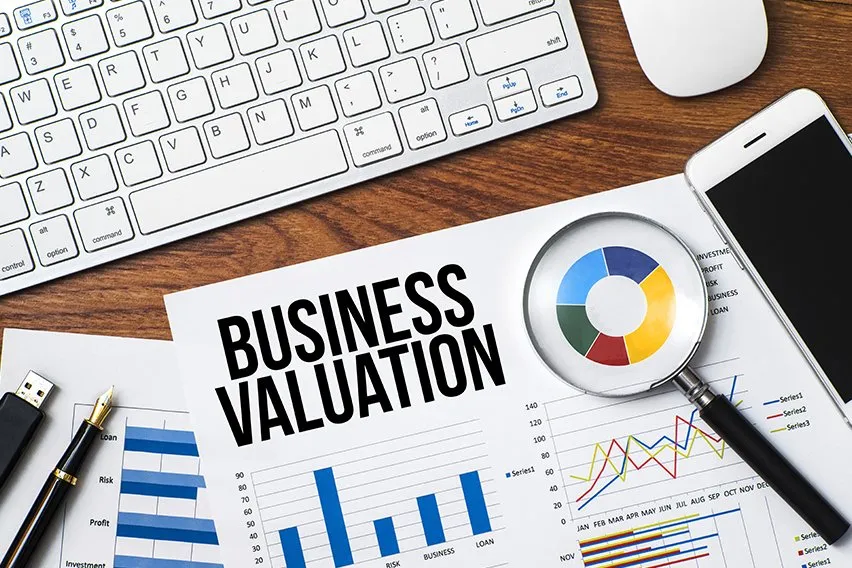9 Essential Components of a Business Plan

Maybe you’re a small business owner that has been in business for years. Or, you could be going through the process of starting a business. Regardless of where you’re at with your career, tasks and responsibilities will come at you quickly.
You need to worry about to-do lists, scheduled meetings, accounting processes and everything in between. When are you supposed to find the time to put your business plan together? It can be an intimidating process to go through, but having a well-thought-out business plan is incredibly important.
There’s no perfect recipe for a business plan, but one of the best things that you can do is write it before you start your business. It can act as a roadmap for where your business is going in the future and how you’re going to get there. So, where do you start?
Let’s take a look at everything that you need to know for writing a business plan that can get you ahead.
Here’s What We’ll Cover:
Tips to Make Your Business Plan Stand Out
9 Components of a Business Plan
What Is a Business Plan?
Think about the last time you needed to get somewhere you hadn’t been before. You might drive, ride your bike or take the train. But no matter the way you get there, you first need to know how to get there. You might put the directions into a GPS, follow a bike path or look up the train schedules.
A business plan works in the exact same way, only it’s a roadmap for your business. It’s a comprehensive document that outlines how your small business is going to grow and develop.
Throughout a business plan, you’re going to communicate who your business is, what you plan on doing and how you plan on doing it. This can give valuable insights into your business for potential investors or hiring new talent.
That all said, a business plan is completely different from a general business concept or business idea. A business plan acts as a blueprint for your business and will highlight who you are. Most banking institutions and venture capitalists won’t invest in a small business unless they have a good business plan.
Potential investors are going to want to know that you have a product or service that fits in the market with a good team in place. Plus, it can show the scalability of your business and how you will grow sales volume.

When Do You Need a Business Plan?
First and foremost, a business plan is important to have regardless of the industry you’re in or the products you offer your customers. It will not only keep you focused and efficient, but a well-written business plan can have other benefits.
A business plan can be helpful when:
- You need new investments, funding or loans
- You are searching for a new partner for your business
- You are attracting and retaining top talent
- You are experiencing slower growth than expected and want a change
Tips to Make Your Business Plan Stand Out
Every business plan is going to be a little different compared to others. This is since your business is unique and your business plan is going to reflect that. But, if your plan is badly written or missing key bits of information then it won’t be as attractive to potential investors.
Here are some tips to help you get the most out of your business plan and make it stand out.
- Make it as easy to read as possible. Investors want something that’s easily scannable and is divided into distinct sections. This way, they can quickly look through the plan and spot the key information.
- Keep it brief. Most business plans are going to range anywhere from 10 – 20 pages. But, as long as you cover the essentials and highlight the key points, less can often be more.
- Make sure you proofread and edit. Always double-check for grammatical errors and that it’s formatted properly. Typos and mistakes are not going to reflect positively for your business.
- Have a quality design. Make sure you have the proper layout, formatting and brand messaging throughout. Bookbinding your business plan can make it look more professional.
- Know all your business margins. Include each and every cost that your business incurs. You can make sure that you’re organizing and assigning those costs to the right product or service you offer.
9 Components of a Business Plan
One of the best things that you can do before writing your business plan is to determine who your audience is going to be. Are you pitching to a room full of potential investors? Do you have a meeting with your local financial institution’s venture funding department? Or, do you just want to create an internal document to help guide your business forward?
Being able to define who your audience is going to be will help you figure out how to write your business plan. For example, the language in your business plan might be different depending on who you want to highlight your business to.
Here are the 9 essential components of a business plan.
1. Executive Summary
Your executive summary is going to be at the front of your plan and be one of the first things that someone reads. But, writing the executive summary should be the last thing that you do, even though it’s first on the list. For now, you can leave your executive summary blank.
Why? Because it lays out every piece of vital information that’s included in your business plan, usually in one page or less. It’s basically a high-level summary of each of the sections in the plan. This means you can’t really write the executive summary first.
2. Company Description
This is where you’re going to highlight your business and what you do. Your company description will include three different things: a mission statement, company history and business objectives.
First, let’s look at your mission statement.
A mission statement is basically the main reason why you’re in business. It’s not necessarily about what you do or the products or services that you sell. Rather, it’s all about why your business does what it does.
Try and make your mission statement inspirational, motivational and even emotional. It’s going to be the foundation on which your business is built. Put some thought into the things that motivate you and the reasons why you started your business in the first place. What do you want to get out of it? Why are you doing it?
You can also think about the causes or different experiences which led you to start your business and the problems it can solve for your customers.
Next, let’s look at your company history.
This doesn’t need to be a long or in-depth section, but more of a highlight of what your business has done in the past and where you stand today. To help make things easier, you can even write about your company history in the form of a profile. Here’s some of the important information you can include in your company history.
- The date you founded or started your business
- Any major milestones worth highlighting
- Your business location, or locations
- How many employees you have
- Your executive leadership and the roles that they have within your company
- The flagship services or products that you offer your customers
Finally, let’s look at your business objectives.
Your business objectives are your guiding lights. They’re the goals that you plan on achieving and they will outline how you plan on getting there. When developing your business objectives, base them on the process of SMART goals.
These are specific, measurable, achievable, realistic and time-bound. Basically, each objective gets tied to the key results you want to achieve. If you don’t clearly define your business objectives, it can make it more difficult for your employees to work efficiently towards a common goal.
3. Market Research and Business Potential
This is the section of your business plan where you outline your target demographic and ideal customer base. You’re also going to do research into the potential and actual size of the market you’re going to enter into. Target markets are going to identify specific information about your customers.
Usually, you can research and find the following information for your target customers:
- Location and average income
- Age and gender
- Education level and profession
- Any activities or hobbies that are relevant
Getting as specific as possible will allow you to illustrate your expertise and get a sense of confidence when it comes to your business. For example, if your target market is extremely broad, it will show investors that it might be more difficult to generate revenue.
4. Competitive Analysis
What is your competition doing? Competitor research is going to start by identifying any companies that are currently in the market you want to enter into. Understanding everything you can about your competition can seem overwhelming and intimidating.
But having this information is extremely useful and will help you make more informed business decisions in the future. Here are a few common questions that you can ask yourself when you’re doing competitive research.
- Where are they investing most in marketing and advertising?
- Do they get any press coverage? If they do, how are they getting it?
- What is their customer service like? Does your customer service stack up against theirs?
- What are their pricing strategies and what are their sales?
- Do they have good reviews on third-party rating platforms?
One of the best ways to do competitive research is to check out your competition’s website. Read through their About Us page or their value and mission statements. This will give you a better understanding of who they are, what they’re doing and how they’re doing it.
Being able to distinguish your business from your competition is a critical element of any business plan. Take some time to think about what sets your business apart and how you’re going to provide a solution to a problem.
5. Describe You Products or Services
What do you offer your customers? What product or service is your business built on? This section of your business plan is going to detail everything about your product or service. Plus, it’s going to highlight why what your business offers is better than the competition.
Touch on the benefits that your product or service offers, the production process and the product life cycle.
When you’re describing the benefits, try and focus on things like unique features and how they translate into benefits. You can also highlight intellectual property rights or patents that differentiate your products.
For the production process, you can explain how you create your existing or new products or services and how you source the raw materials. Other things such as quality control, quality assurance and supply chain logistics can get included.
With your product life cycle, you can highlight any cross-sells, down-sells or upsells. As well as your future plans for research and development.

6. Marketing and Sales Strategy
You could spend weeks putting together an in-depth business plan that highlights your company and what you do. But, if you don’t have a solid marketing and sales strategy in place then it won’t matter how good your business plan is. You still need to know how you’re going to generate sales.
This part of your plan is entirely dependant on the type of products or services that you offer. You can include your company’s value proposition, ideal target market and your existing customer segments. Then, you can start with some more specifics.
What’s the launch plan that you have in place to help attract new business? What are your growth tactics to help your business expand in the future? Do you have any retention strategies in place, such as customer loyalty or referral programs? What about advertising across print, social media, search engines or television?
These are all good questions to ask yourself when putting together your sales and marketing strategy. You can use this part of the business plan to highlight your business strengths and how you differentiate from the competition.
7. Business Financials
If you are just starting your business then you aren’t going to have much financial data. You won’t have things like financial statements or an income statement. But, you still need to put together some type of financial plan and budget. If you have been operating for a while, you will have some important information to include, such as:
- Profit and loss statements
- Income statements
- Cash flow statement
- Balance sheets
- Revenue vs net income
- The ratio of liquidity to debt repayment
Make sure that the data and figures that you include are accurate. For example, things like costs, profit margins and sale prices can be closely linked together. If you don’t have access to historical data, you can put together financial projections.
8. Management and Organization
The people that you have working for your business are the driving force behind your overall success. Without the right people in place, your business won’t likely be successful. This is the part of your business plan where you’re going to highlight your team.
Identify the members of your team and explain how they are going to help turn your business idea into a reality. Plus, you can highlight the qualifications and expertise of each team member. This will position your business as one that’s worth potentially investing in.
9. Include an Appendix
This is where you’re going to compile and include everything that both investors and your team will need access to. Include everything that’s useful for an investor to conduct due diligence.
Here are some of the most common official documents you can include in a well-organized appendix.
- Any legal documents, local permits or deeds
- Professional licenses or business registries
- Any patents or intellectual property
- Any industry memberships or associations
- Your business identification numbers or codes
- Any key purchase orders or customer contracts that you have in place
It can also be helpful to include a table of contents in your appendix. This can make it easier to find the right information or allow you to highlight the most important documents.
Key Takeaways
It’s worth noting that a business plan doesn’t just have to be a way to attract potential investors. There are several other reasons why having a business plan is important.
You can better clarify the goals and objections that you want your business to accomplish and you can gain insights into your target market. Team members can have a much better sense as to the direction the business is going and how they can contribute to its success and growth. Plus, you can establish and define the roles of each team member, all while setting achievable benchmarks.
Creating a business plan will act as a roadmap for your business. It’s going to highlight the goals and objectives you have. As well as touch on things like marketing, advertising, your management team and financials. Here’s a quick review of the 9 essential components of a business plan.
- Executive summary, which you will write after you have completed steps 2 – 9
- Company description, including a mission statement, company history and business objectives
- Competitive analysis
- Market research and business potential
- Your products or services
- Marketing and sales strategy
- Business financials
- Management and organization
- Appendix
Follow the 9 components outlined in this article to help you develop a business plan. You can clearly define your business goals and have a roadmap to help your business be successful.
Did you enjoy reading this guide? Head over to our resource hub for more great content!
RELATED ARTICLES

 Understanding the Top Business Valuation Methods
Understanding the Top Business Valuation Methods ASPE Vs IFRS: What’s the Difference?
ASPE Vs IFRS: What’s the Difference? Push Vs Pull Strategy: What’s the Difference?
Push Vs Pull Strategy: What’s the Difference? What Is a Suspense Account?
What Is a Suspense Account? Average Inventory: What It Is & How To Calculate It?
Average Inventory: What It Is & How To Calculate It? What Is a Bank Transit Number?
What Is a Bank Transit Number?